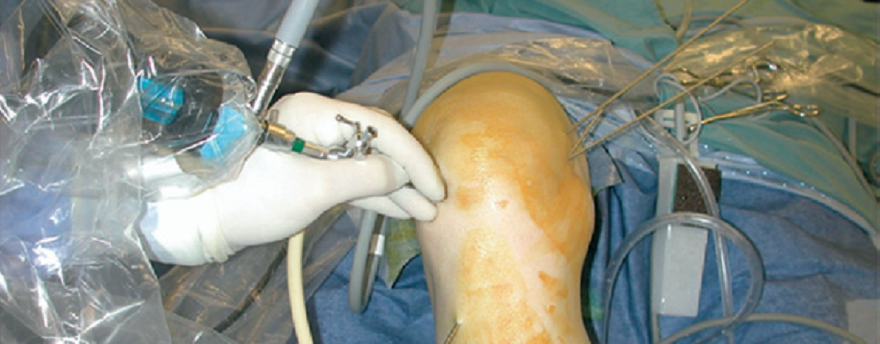Bacterial Biofilms and Periprosthetic Infections - how do we know if a failure is 'aseptic'?
Bacterial Biofilms and Periprosthetic Infections
This is an important article because it emphasizes that low-virulence infections sheltered in biofilms may underlie many apparently ‘aseptic’ failures of prosthetic joint arthroplasty.
The authors point out that in nature most bacteria in nature grow as biofilms rather than as isolated or ‘planktonic’ colonies. Interestingly, the biofilm matrix has a structure and function analogous to the extracellular matrix that is the hallmark of higher-order multicellular organisms. As with the extracellular matrix, the biofilm matrix is produced by cells but, in this case, bacterial cells. The biofilm matrix offers protection as well as provides an organizing scaffold, which can facilitate the metabolic activity and even communication among the bacteria. Bacteria in biofilms are relative protected from immune system attack and are less susceptible to antibiotics. In a biofilm, bacteria can be tolerant to antibiotics at concentrations that are several hundredfold greater than that needed to kill planktonic bacteria. While in biofilms, bacteria seem to exist in a more quiescent, less virulent state; however, they can still elicit a host inflammatory response that contributes to continual adjacent tissue destruction that results ultimately in the clinical symptoms of pain and implant loosening seen in longstanding chronic periprosthetic infection.
It can be difficult to culture biofilm bacteria. Special methods may be necessary, including polymerase chain reaction methodologies and mass spectrometry. These methods have been successful in identifying organisms in culture-negative periprosthetic infection as well as in cases of revision arthroplasty thought to be due to aseptic loosening. The authors suggest that many ‘aseptic’ failures of arthroplasty components may actually involve low-grade chronic infections that simply present as chronic pain, which may be the only clinical symptom.
It can be difficult to resolve such infections. The authors suggest that any surgical treatment will ultimately fail if that treatment does not adequately remove the biofilm at the infection site.
A single-stage exchange can be successful if it adequately removes the biofilm at the infection site: that on the prosthesis as well as that in surrounding tissues.
While the authors do not discuss chronic low grade shoulder infections, it is well recognized that the commonly recovered Priopionibacterium is an excellent former of biofilms
This is an important article because it emphasizes that low-virulence infections sheltered in biofilms may underlie many apparently ‘aseptic’ failures of prosthetic joint arthroplasty.
The authors point out that in nature most bacteria in nature grow as biofilms rather than as isolated or ‘planktonic’ colonies. Interestingly, the biofilm matrix has a structure and function analogous to the extracellular matrix that is the hallmark of higher-order multicellular organisms. As with the extracellular matrix, the biofilm matrix is produced by cells but, in this case, bacterial cells. The biofilm matrix offers protection as well as provides an organizing scaffold, which can facilitate the metabolic activity and even communication among the bacteria. Bacteria in biofilms are relative protected from immune system attack and are less susceptible to antibiotics. In a biofilm, bacteria can be tolerant to antibiotics at concentrations that are several hundredfold greater than that needed to kill planktonic bacteria. While in biofilms, bacteria seem to exist in a more quiescent, less virulent state; however, they can still elicit a host inflammatory response that contributes to continual adjacent tissue destruction that results ultimately in the clinical symptoms of pain and implant loosening seen in longstanding chronic periprosthetic infection.
It can be difficult to culture biofilm bacteria. Special methods may be necessary, including polymerase chain reaction methodologies and mass spectrometry. These methods have been successful in identifying organisms in culture-negative periprosthetic infection as well as in cases of revision arthroplasty thought to be due to aseptic loosening. The authors suggest that many ‘aseptic’ failures of arthroplasty components may actually involve low-grade chronic infections that simply present as chronic pain, which may be the only clinical symptom.
It can be difficult to resolve such infections. The authors suggest that any surgical treatment will ultimately fail if that treatment does not adequately remove the biofilm at the infection site.
A single-stage exchange can be successful if it adequately removes the biofilm at the infection site: that on the prosthesis as well as that in surrounding tissues.
While the authors do not discuss chronic low grade shoulder infections, it is well recognized that the commonly recovered Priopionibacterium is an excellent former of biofilms
Instructional Course Lecture | December 18, 2013
Bacterial Biofilms and Periprosthetic Infections
J Bone Joint Surg Am, 2013 Dec 18;95(24):2223-2229
Extract
The diagnosis and treatment of periprosthetic infection after joint arthroplasty is often frustrating for the orthopaedic surgeon. The application of certain diagnostic criteria and different treatment strategies can be better directed if these infections are placed in the context of microbial biofilms. An understanding of this biofilm mode of microbial infection can help to explain the phenomenon of culture-negative infection as well as provide an understanding of why certain treatment modalities often fail. Continued basic research into the role of biofilms in infection will likely provide improved strategies for the clinical diagnosis and treatment of periprosthetic infection.








